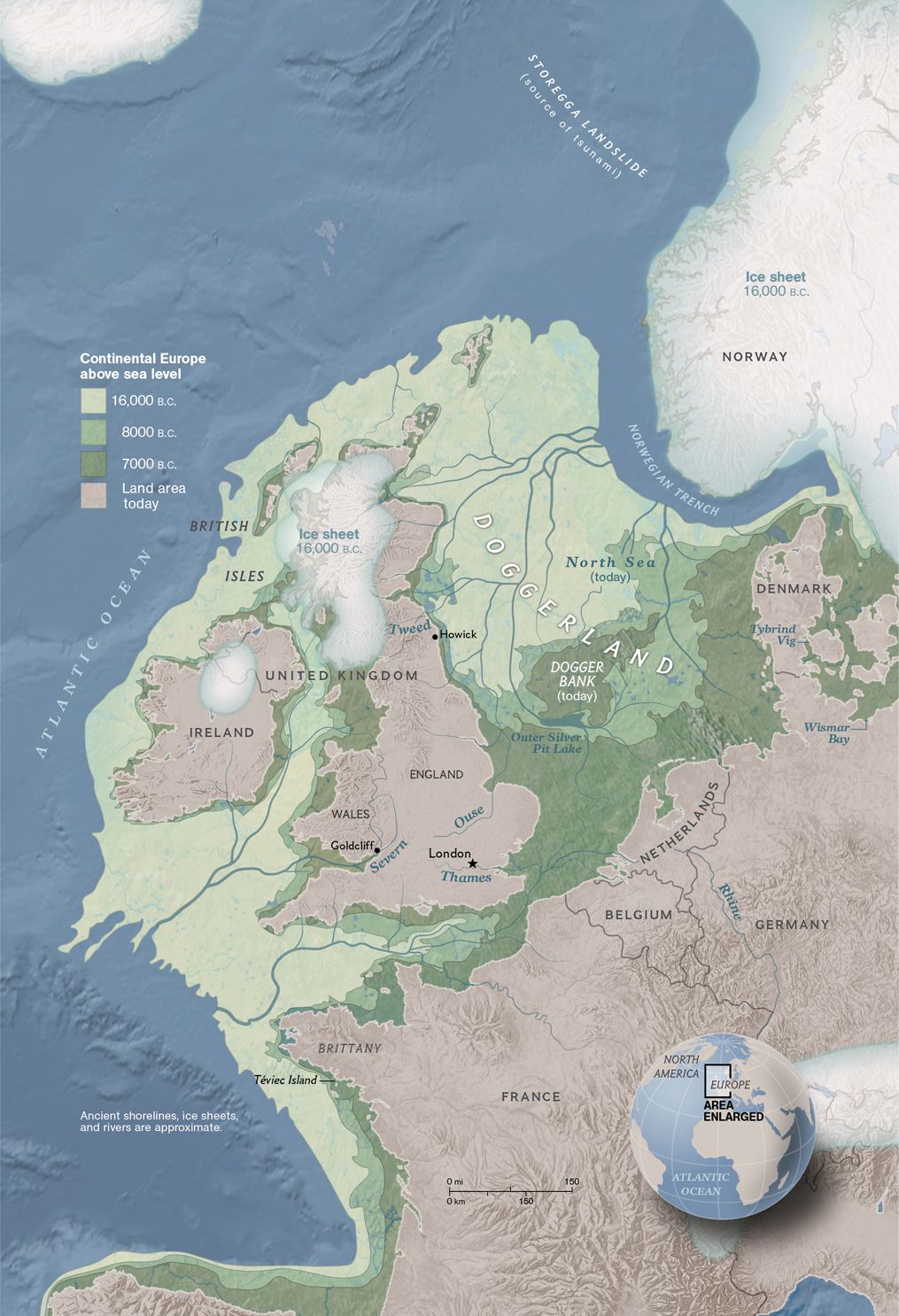In January of 2019, I wrote the following speculative piece:
16 months later, I believe that the article is even more relevant, now that Coronavirus/Covid-19 has concentrated minds (and leaving aside the fact that the Chinese virus is overblown and also being used by the System to bluff people into becoming members of police states across Europe and beyond).
I was just reading again about “Doggerland”, which is not a gonzo-literature novel about some of the leisure activities of a sub-set of the English pleb-dom, but a large territory that once existed between the area now designated as “UK”, and those of present-day “Denmark”, “Germany”, “Netherlands” etc.
 https://www.nationalgeographic.org/maps/doggerland/
https://www.nationalgeographic.org/maps/doggerland/
https://en.wikipedia.org/wiki/Doggerland
and see the very interesting series of maps below
 [By Francis Lima – Own work, CC BY-SA 4.0, https://commons.wikimedia.org/w/index.php?curid=49850020] It can be seen that, at its greatest extent, what is now called “Doggerland” (a term invented only in the 1990s), together with similar areas in the Atlantic off (mainly) the present-day coasts of the UK and Ireland (the ancient land of Lyonesse, of Arthurian legend), was larger in extent than the present-day UK.
[By Francis Lima – Own work, CC BY-SA 4.0, https://commons.wikimedia.org/w/index.php?curid=49850020] It can be seen that, at its greatest extent, what is now called “Doggerland” (a term invented only in the 1990s), together with similar areas in the Atlantic off (mainly) the present-day coasts of the UK and Ireland (the ancient land of Lyonesse, of Arthurian legend), was larger in extent than the present-day UK.
Consideration of these matters gives perspective.
Videos about the above matters:
and while looking at those Doggerland videos, I also saw this one (below)
Fascinating, though possibly not a good idea even if do-able.. How about starting with something smaller, such as the Irish Sea? (only, sort-of, joking…).
In fact, large-scale projects are not always a poor idea. One which has interested many is that of creating a canal from the Mediterranean to the Qattara Depression in the Western Desert of Egypt, then using gravity to move seawater the 40 miles to the Depression.
The Qattara Depression is on average 200 ft (60m) below sea level, though the lowest part is 440 ft (134m) below sea level. No-one lives there, though the very isolated oasis of Qara https://en.wikipedia.org/wiki/Qara_Oasis lies near the Western edge of the Depression, some 47 miles (75km) North-East of the nearest larger oasis, Siwa. https://en.wikipedia.org/wiki/Siwa_Oasis
I myself stayed in Siwa for a month, in early 1998, out of three months spent in Egypt (on that trip).


Siwa is 189 miles (305km) from the Mediterranean Sea coast. British or American people tend to think of an oasis as being a small lake with a fringe of palm trees, but Siwa is, at greatest extent, 50 miles long and 12 miles wide, and has a total population of some 30,000 (though when you are there —admittedly I was there over 20 years ago— the place does not seem in any way heavily populated, rather the reverse). It has about 350 freshwater springs (the water of which is exported to Alexandria and Cairo in plastic bottles), 300,000 date palms, 70,000 olive trees (and some fruit trees, too).
Reverting to Qattara, the Depression is 190 miles (300km) long by 84 miles (135km) wide. Area: 7,570 square miles, about the same as mainland Wales.
A project to flood the Depression would be hugely beneficial. Fish would flood in with the water, it would change the regional climate for the better, and it would enable hydropower as well.
It may be that, by using hydropower and solar power, new eco-cities or towns, even horticultural areas, could be created and maintained, supplied with fresh water via desalination.

https://en.wikipedia.org/wiki/Qattara_Depression
https://en.wikipedia.org/wiki/Qattara_Depression_Project
Fact follows fiction (again): https://en.wikipedia.org/wiki/Invasion_of_the_Sea
Anwar Sadat was said to have been seriously interested in the Qattara idea, but when he was assassinated, the project was again mothballed.
Other projects I have seen or read about
https://en.wikipedia.org/wiki/Sundrop_Farms
In Iran, not long before the Islamic Revolution unseated the Shah , there was a government programme to replace sand dunes and semi-desert with forest. Of course, the backward mullahs did not continue with it. I read about the project in the National Geographic. Brilliant.
First, the sand dunes were coated with a very thin layer of crude oil, sprayed from tanked vehicles. Secondly, seeds of the tamarisk tree (salt-resistant and heat-resistant) https://en.wikipedia.org/wiki/Tamarix were spread over the oil layer.
 [above: tamarisk tree in the Negev Desert, Israel. CC BY-SA 3.0, https://commons.wikimedia.org/w/index.php?curid=293521]
[above: tamarisk tree in the Negev Desert, Israel. CC BY-SA 3.0, https://commons.wikimedia.org/w/index.php?curid=293521]
The thin oil layer prevented the seeds from being blown away by wind, and anchored the tiny shoots when germinated. The climate had enough moisture for their survival. The tiny growing shoots and trees (within a few years about 4 feet high) were protected from goats and their owners, if any, by fences and a ranger force.
Once the trees were mature (some of the 60 types of tamarisk grow as high as 60ft/18m), the idea was that the climate and ecology would be markedly improved.
Under the Shah, there was to have been a roll-out across Iran. It never happened. Sad.
There have been and still are many large-scale projects of great value, both engineering projects and more obviously “environmental” ones. Most founder on the rocks of politics and/or finance.
[Note: the above first appeared in my daily blog]
Update, 1 December 2020

4 thoughts on “Lost Doggerland, Some Historical Changes and Some Large-Scale Projects”